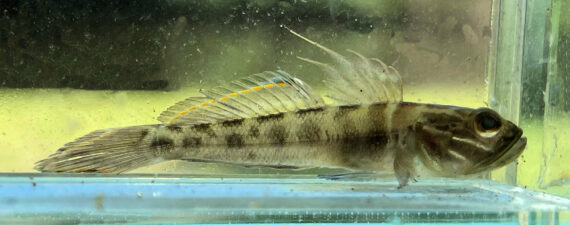Clown Goby, Microgobius gulosus
 Clown Goby, Microgobius glosssus, Female. Fish caught from coastal of Palm Beach County, Florida, July 2021. Catch, photograph and identification courtesy of Luke Ovgard, Klamath Falls, Oregon.
Clown Goby, Microgobius glosssus, Female. Fish caught from coastal of Palm Beach County, Florida, July 2021. Catch, photograph and identification courtesy of Luke Ovgard, Klamath Falls, Oregon.
The Clown Goby, Microgobius glosssus, is a member of the Goby or Gobiidae Family, that is known in Mexico as gobio payaso. The Microgobius Genus has fourteen global members of which three are found in Mexican waters of the Atlantic.
The Clown Goby has a compressed head and body. They are an overall light gray-brown color with areas of bright iridescent blue and/or yellow. Their head is dusky with two oblique off-white stripes below that meet at the top corner of the gill cover. They are sexually dimorphic with the males having two or three irregular rows of eight or nine dusky blotches above the midline that transitions to pale ventrally; they have an off-white vertical bar behind the pectoral fin. Their anal fin is dusky, their caudal fin is dusky with a dark margin and a hyaline sub-marginal stripe, their first dorsal fin is dusky with dark blotches on the base, their second dorsal fin has four or five dark basal blotches, their pectoral fins are pale and mottled at the base, and, their pelvic fins are dusky. The females are similar in color but the colors are more intense and better defined and their caudal fin has four or five irregular diagonal rows of dark spots on the upper half and the lower half is dusky, the second dorsal fin has three irregular rows of spots and a dusky margin. Their anal fin has 1 spine and 15 to 18 rays; their caudal fin is long and oval; their first dorsal fin and 7 spines with the third and four being filaments with the longest reaching the mid-point of the second dorsal fin in males and much shorter in females; the second dorsal fin has 1 spine and 14 to 17 rays; the pectoral fins have 19 to 24 rays; and, their pelvic fins have 1 spine and 5 rays and are fused to form a disc. Their mouth is large and oblique, and the lower jaw has 8 canine teeth in the outer row. Their body is covered with small smooth scales. They do not have a lateral line.
The Clown Goby is a demersal species that is found within a wide range of salinities within muddy substrate and often in freshwater and estuarine habitats at depths up to 75 m (250 feet). They are amphidoromous transiting back and forth between fresh and salt water during non-breeding seasons. They can be found in very large numbers. They are asexually dimorphic benthic spawner with a haremic mating structure that occurs in burrows. They have a low fecundity and provide care for the young with aggressive behavior. They reach a maximum of 7.5 cm (3.0 inches) in length. They feed on annelids and crustaceans. They are found mixed in with the Code Goby, Gobiosoma robustrum, in areas where their ranges overlap. The Clown Goby is poorly studied with very limited information available about their lifestyle and behavioral patterns including specific details on age, growth, longevity, movement patterns, diet, habitat use, and reproduction.
The Clown Goby is a resident of Mexican waters of the Atlantic Ocean but has a limited distribution being found only from the Texas boarder south to Veracruz in the western Gulf of Mexico.
The Clown Goby, within their known range, can be confused with the Seminole Goby, Microgobius carri (lower lobe of caudal fin is yellow) and the Spotfin Goby, Oxyurichthys stigmalophius (large black blotch at the rear of first dorsal fin).
From a conservation perspective the Clown Goby is currently considered to be of Least Concern, with stable widely distributed populations. They are small in stature and are of little interest to most. They are utilized by the aquarium trade on a limited basis and can be raised in captivity.